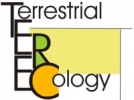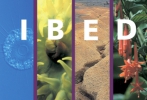You are here
GPS tracking network for large birds
In the framework of the Flemish contributions to the LifeWatch infrastructure, a high-tech sensor network was installed to better monitor the habitat use and migration patterns of large and medium sized birds.
Research
Since 1999, the Research Institute for Nature and Forest (INBO) studies the postnuptial migration, and mate and site fidelity of large gulls, using observer sightings of colour-ringed individuals. Using similar methods and since 2011, the INBO also studies the ecology of the Western Marsh Harrier, an Appendix I species of the European Birds Directive whose Belgian population is in decline. The sightings provided by citizen scientists have been used in many studies, but studying emerging habitat use and migration patterns is difficult, since the data are strongly biased towards populated areas and locations where the rings can easily be read.
To better understand the habitat use and migration patterns of large birds, the Bird Tracking Network was established in the framework of the Flemish contributions to the LifeWatch infrastructure. The network started in May 2013 when European herring gulls (Larus argentatus Pontoppidan, 1736), Lesser black-backed gulls (Larus fuscus Linnaeus, 1758) and Western marsh harriers (Circus aeruginosus Linnaeus, 1758) were tagged with light-weight, solar-powered GPS tags. These tags were developed by UvA-BiTS (LifeWatch NL) and measure position, altitude, temperature and optionally acceleration at defined intervals, collectively detailed information on the movement of the birds. In the following years, more individuals were tagged, as well as a new species: Eurasian oystercatchers (Haematopus ostralegus Linnaeus, 1758) in a joint project with SOVON (NL).
More recently, 3G GSM transmitters became available for medium sized bird species. From 2019 on, Ornitela’s OrniTrack transmitters are used in the LifeWatch bird tracking network on juvenile Lesser black-backed gulls (Larus fuscus Linnaeus, 1758), Mediterranean gulls (Ichthyaetus melanocephalus Temminck, 1820), Eurasian curlews (Numenius arquata Linnaeus, 1758), and the rodent specialized birds of prey: Short-eared owl (Asio flammeus Pontoppidan, 1763), Common buzzard (Buteo buteo Linnaeus, 1758), Western marsh harrier (Circus aeruginosus Linnaeus, 1758), Hen harrier (Circus cyaneus Linnaeus, 1766), and Montagu’s harrier (Circus pygargus Linnaeus, 1758).
The bird tracking consortium contains the following Flemish partners: INBO, VLIZ, Ghent University (Terrestrial Ecology Unit) and Antwerp University (Behavioural Ecology and Ecophysiology). The Bird Tracking Network gave rise to international collaborations with the University of Amsterdam (UvA, LifeWatch coordinator in the Netherlands), Estación Biológica de Doñana, University of St Andrews, and Movebank. INBO and VLIZ joined the Next Generation Animal Tracking consortium (NGAT) initiated by the Universities of Antwerp and Ghent. This multidisciplinary consortium was established to unite international experts, promote the development of analytical tools and boost population and community ecology research.
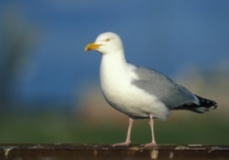
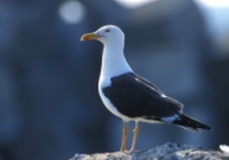
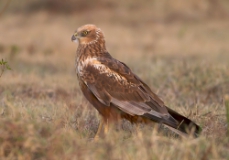
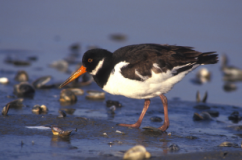
From left to right: European Herring Gull (©Misjel Decleer); Lesser Black-backed Gull (©Misjel Decleer); Western Marsh Harrier (©The Internet Bird Collection); Eurasian Oystercatcher (©Misjel Decleer)
Infrastructure
GPS trackers and ground stations for data transfer
The use of GPS tags with tri-axial accelerometers allow the researchers to efficiently and accurately monitor bird behaviour and migration patterns. Since 2013, over 240 birds have been tagged with UvA-BiTS GPS trackers. Data collected by the trackers are transmitted to ground stations, from where these are transferred to the UvA-BiTS data platform developed by LifeWatch NL. Ground stations were installed on fixed locations near breeding colonies, or on various locations depending on sightings of the tagged birds (e.g., birds of prey that do not breed in colonies). Migration data could only be downloaded if and once the birds returned. 2 ground stations are still active in gull colonies in Oostende and Zeebrugge, but overall, this method is being phased out for 3G GSM transmitters.
3G GSM transmitters
More recently, 3G GSM transmitters became available for medium sized bird species. This technology does not require the use of ground stations. Another advantage is that data are sent (near-)realtime, which is particularly interesting during migration or when birds don’t return to the area where they were captured and tagged. From 2019 on, Ornitela’s OrniTrack transmitters are used in the LifeWatch bird tracking network. These transmitters directly upload data to a central server using the telecom network.
Data
The trackers are programmed to measure the bird's position and altitude at regular intervals using GPS. In addition, air temperature and bird activity (using an accelerometer) are measured. Data collected by UvA-BiTS trackers are stored until those can be transmitted to a ground station or relay antenna using Bluetooth, which is especially required during the birds' annual migration, when no data connection can be established. Ground station software allows the researcher to define and send the measurement setting for each tracker. Data are then uploaded to a central database at IBED. These data are accessible to registered users via a virtual lab. Data collected by Ornitela trackers are directly transmitted to a central database at Ornitela. Data are accessible to registered users at the OrniTrack Control panel which also allows the remote management of measurement settings of the trackers.
To make these data more widely accessible, the INBO team developed workflows to extract and transform data from the UvA-BiTS and Ornitela databases to the Movebank data format. Standardized datasets are then uploaded to and made publicly available on Movebank, an online platform for animal tracking data that is generally used within the movement ecology community. In a next step, datasets from Movebank are transformed to Frictionless Data Packages and archived as open data on Zenodo where they get a citable DOI. Scripts and workflows are documented on GitHub. Ten bird tracking datasets are available on Movebank and Zenodo as open data. See this table for an overview of all bird tracking datasets published.
Useful links
- Next Generation Animal Tracking consortium
- Map of the LifeWatch Observatory
- List of LifeWatch Belgium publications
- Overview of published bird tracking datasets
Media and outreach
- 2020-07-09, Natuurpunt nieuws: Bruine kiekendieven uit Zweden, Nederland en België opgevolgd met zenders
- 2020-07-01, INBO nieuwsbrief: Verschilt het trekgedrag van bruine kiekendieven uit de Lage Landen van deze uit Scandinavië?
- 2020-06-16, Nature Today: Trekgedrag van bruine kiekendieven uit de lage landen en Scandinavië
- 2018-03-19, National geographic: Kleine mantelmeeuw: Lenige opportunist
- 2018-03-01, Nature Today: Bruine kiekendief in de Lage Landen ook akkervogel
- 2014-07-10, Eos: Het geheime leven van vogels
- 2014-06-07, Het Laatste Nieuws: Meeste meeuwen brengen geen overlast
- 2013-12-01, Natuurpunt blad: Echte Belgen
- 2013-06-18, Het Nieuwsblad: Zeemeeuwen gaan elke dag chips eten in Moeskroen
- 2013-06-18, Het Laatste Nieuws: Zeemeeuwen gaan elke dag chips eten in Moeskroen
- 2013-06-18, VRTnws: Zeebrugse meeuwen eten chips in Moeskroen
Most recent publications
- van Rees, C.B.; Aragonés, D.; Bouten, W.; Thaxter, C.B.; Stienen, E.W.M.; Bustamante, J.; Green, A.J. (2021). Dynamic space use of Andalusian rice fields by Lesser Black‐backed Gulls (Larus fuscus) is driven by flooding pattern. Ibis 163(4): 1252-1270. https://dx.doi.org/10.1111/ibi.12968 [link to IMIS record]
- Baert, J.M.; Stienen, E.W.M.; Verbruggen, F.; Van de Weghe, N.; Lens, L.; Müller, W. (2021). Context‐dependent specialisation drives temporal dynamics in intra‐ and inter‐individual variation in foraging behaviour within a generalist bird population. Oikos 130(8): 1272-1283. https://doi.org/10.1111/oik.08067 [link to IMIS record]
- Kavelaars, M.M.; Baert, J.M.; Van Malderen, J.; Stienen, E.W.M.; Shamoun-Baranes, J.; Lens, L.; Müller, W. (2021). Simultaneous GPS-tracking of parents reveals a similar parental investment within pairs, but no immediate co-adjustment on a trip-to-trip basis. Movement Ecology 9(1): 42. https://dx.doi.org/10.1186/s40462-021-00279-1 [link to IMIS record]
- Salas, R.; Müller, W.; Vercruijsse, H.; Lens, L.; Stienen, E. (2020). Forced nest site relocations negatively affect reproductive investment in a colonial seabird species. Biological Conservation 246: 108550. https://dx.doi.org/10.1016/j.biocon.2020.108550 [link to IMIS record]
- Kavelaars, M.M.; Baert, J.M.; Stienen, E.W.M.; Shamoun-Baranes, J.; Lens, L.; Müller, W. (2020). Breeding habitat loss reveals limited foraging flexibility and increases foraging effort in a colonial breeding seabird. Movement Ecology 8(1): 45. https://dx.doi.org/10.1186/s40462-020-00231-9 [link to IMIS record]
- Milotic, T.; Desmet, P.; Anselin, A.; De Bruyn, L.; De Regge, N.; Janssens, K.; Klaassen, R.; Koks, B.; Schaub, T.; Schlaich, A.; Spanoghe, G.; T’Jollyn, F.; Vanoverbeke, J.; Bouten, W. (2020). GPS tracking data of Western marsh harriers breeding in Belgium and the Netherlands. ZooKeys 947: 143-155. https://dx.doi.org/10.3897/zookeys.947.52570 [link to IMIS record]
- van Rees, C.B.; Aragonés, D.; Bouten, W.; Thaxter, C.B.; Stienen, E.; Bustamante, J.; Green, A. (2020). Dynamic space use of Andalusian rice fields by overwintering lesser black-backed gulls is driven by harvest-related flooding. Research Square 45637/v1: 30 pp. https://dx.doi.org/10.21203/rs.3.rs-45637/v1 [link to IMIS record]
- Vansteelant, W.M.G.; Klaassen, R.; Strandberg, R.; Janssens, K.; T´Jollyn, F.; Bouten, W.; Koks, B.J.; Anselin, A. (2020). Western marsh harriers Circus aeruginosus from nearby breeding areas migrate along comparable loops, but on contrasting schedules in the West African–Eurasian flyway. Journal of Ornithology 161: 953-965. https://dx.doi.org/10.1007/s10336-020-01785-6 [link to IMIS record]
- Martín-Vélez, V.; Sánchez, M.I.; Shamoun-Baranes, J.; Thaxter, C.B.; Stienen, E.W.M.; Camphuysen, K.C.J.; Green, A.J. (2019). Quantifying nutrient inputs by gulls to a fluctuating lake, aided by movement ecology methods. Freshwater Biology 64(10): 1821-1832. https://dx.doi.org/10.1111/fwb.13374 [link to IMIS record]
- van den Bosch, M.; Baert, J.M.; Müller, W.; Lens, L.; Stienen, E. (2019). Specialization reduces foraging effort and improves breeding performance in a generalist bird. Behavioural Ecology 30(3): 792-800. https://dx.doi.org/10.1093/beheco/arz016 [link to IMIS record]
- Sotillo, A.; Baert, J.M.; Müller, W.; Stienen, E.W.M.; Soares, A.M.V.M.; Lens, L. (2019). Time and energy costs of different foraging choices in an avian generalist species. Movement Ecology 7(1): 41. https://dx.doi.org/10.1186/s40462-019-0188-y [link to IMIS record]
- Vanermen, N.; Courtens, W.; Daelemans, R.; Lens, L.; Müller, W.; Van de walle, M.; Verstraete, H.; Stienen, E. (2019). Attracted to the outside: a meso-scale response pattern of lesser black-backed gulls at an offshore wind farm revealed by GPS telemetry. ICES Journal of Marine Science 77(2): https://dx.doi.org/10.1093/icesjms/fsz199 [link to IMIS record]
- Kavelaars, M.M.; Stienen, E.; Matheve, H.; Buijs, R.-J.; Lens, L.; Müller, W. (2018). GPS tracking during parental care does not affect early offspring development in lesser black-backed gulls. Mar. Biol. (Berl.) 165(5): 87. https://hdl.handle.net/10.1007/s00227-018-3347-6 [link to IMIS record]
- Baert, J.M.; Stienen, E.W.M.; Heylen, B.C.; Kavelaars, M.M.; Buijs, R.-J.; Shamoun-Baranes, J.; Lens, L.; Müller, W. (2018). High-resolution GPS tracking reveals sex differences in migratory behaviour and stopover habitat use in the Lesser Black-backed Gull Larus fuscus. NPG Scientific Reports 8(1): 5391. https://hdl.handle.net/10.1038/s41598-018-23605-x [link to IMIS record]
- Santos, C.S.A.; Blondel, L.; Sotillo, A.; Müller, W.; Stienen, E.W.M.; Boeckx, P.; Soares, A.M.V.M.; Monteiro, M.S.; Loureiro, S.; de Neve, L.; Lens, L. (2017). Offspring Hg exposure relates to parental feeding strategies in a generalist bird with strong individual foraging specialization. Sci. Total Environ. 601-602: 1315-1323. https://hdl.handle.net/10.1016/j.scitotenv.2017.05.286 [link to IMIS record]
- Stienen, E.W.M.; Desmet, P.; Aelterman, B.; Courtens, W.; Feys, S.; Vanermen, N.; Verstraete, H.; Van de walle, M.; Deneudt, K.; Hernandez, F.; Houthoofdt, R.; Vanhoorne, B.; Bouten, W.; Buijs, R.-J.; Kavelaars, M.; Müller, W.; Herman, D.; Matheve, H.; Sotillo, A.; Lens, L. (2016). GPS tracking data of Lesser Black-backed Gulls and Herring Gulls breeding at the southern North Sea coast. ZooKeys 555: 115-124. https://dx.doi.org/10.3897/zookeys.555.6173 [link to IMIS record]
- Gupta, T.; Santos, C.S.A.; Sotillo, A.; De Neve, L.; Stienen, E.W.M.; Müller, W.; Lens, L. (2016). Nutritional stress causes heterogeneous relationships with multi-trait FA in Lesser black-backed gull chicks: an aviary experiment. Symmetry 8(11): a133 [1-12]. https://dx.doi.org/10.3390/sym8110133 [link to IMIS record]
- Sotillo, A.; Depestele, J.; Courtens, W.; Vincx, M.; Stienen, E.W.M. (2014). Consumption of discards by Herring Gulls Larus argentatus and Lesser Black-backed Gulls Larus fuscus off the Belgian coast in the breeding season. Ardea 102(2): 195-205. https://dx.doi.org/10.5253/arde.v102i2.a9 [link to IMIS record]

